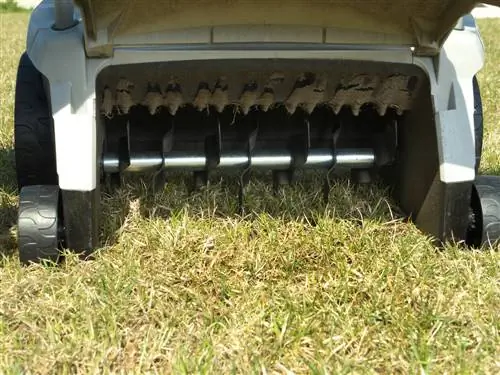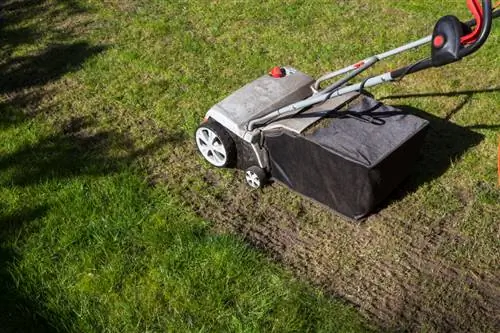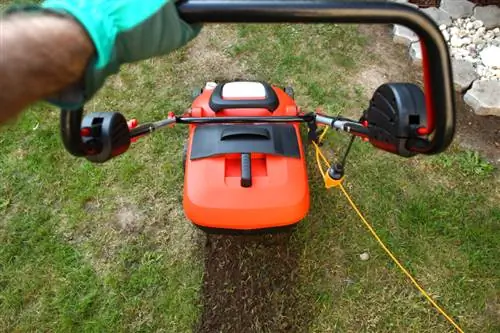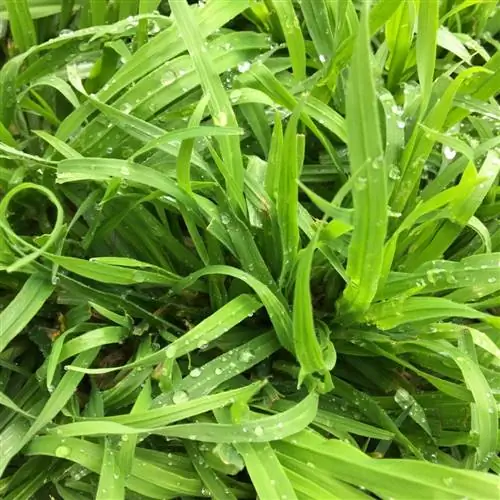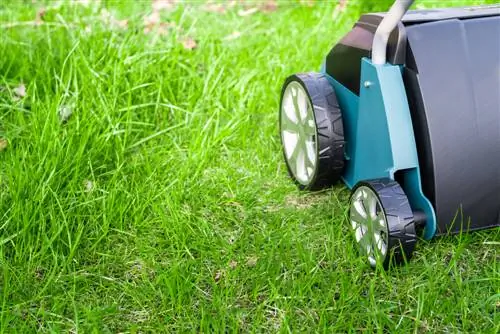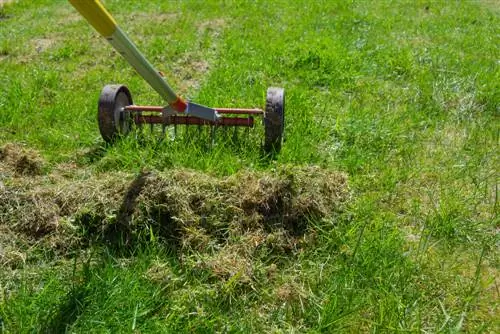- Author admin [email protected].
- Public 2023-12-16 16:46.
- Last modified 2025-06-01 06:02.
If moss and weeds spoil the lawn, simply reseeding will not solve the problem. The magic word for an even, lush green lawn is scarifying. If the gardener is dealing with this special care measure for the first time, the question arises as to the right time. This guide explains when and how to scarify correctly.

When should you scarify your lawn?
The best time for scarifying is between April and May, when the ground temperature is consistently above 10 degrees Celsius and delayed ground frosts are no longer expected. In autumn you can also scarify between the beginning of September and mid-October.
What does the term scarifying mean?
The term scarifying was coined in England, the motherland of the immaculate lawn. The name contains the English words “vertical” for vertical and “to cut” for cutting. However, the process was developed in 1955 in the USA by Thomas Mascaro, whose inventions can still be admired at Penn State University today.
In this care measure, the turf is scratched using a rotating knife roller. Scarifiers are available with an electric or gasoline engine and as a hand-held device. The aim of scarifying is primarily to remove moss and thatch in order to better supply the noble grasses with air and light. Furthermore, the lawn becomes more permeable, which effectively prevents harmful waterlogging and soil compaction.
When is the best time?
The ideal time window is open from April to May. Growth begins in this phase, so that the lawn can then regenerate quickly. This aspect is extremely relevant for choosing the right time, because scarifying is extremely stressful for any lawn. If you use a scarifier in the warm, dry summer, you will struggle for many weeks with a plucked green area that only slowly turns into a green carpet closes. How to determine the optimal time:
- The ground temperature is continuously above 10 degrees Celsius
- No more delayed ground frosts are expected
- It didn't rain at the lecture
- The lawn is not completely dry
In autumn, another window of opportunity opens up to remove thatch from a mossy lawn. Between the beginning of September and mid-October there is nothing wrong with scarifying the green area for the first time or a second time. The work should be completed by the end of October at the latest, otherwise there will be too little time for regeneration.
Should the lawn be prepared?
With careful preparation in advance, you can ensure that your lawn recovers quickly after scarifying. The following process has proven to be excellent in professional care:
- Mow the lawn twice after the winter break
- Fertilize the lawn 10 to 14 days before scarifying
- Wrinkle the green area repeatedly so that the fertilizer is completely absorbed
The previous supply of nutrients stimulates the growth of the lawn grasses so that they are well prepared for the subsequent procedure.
Properly scarifying - How does it work?
Verticutting devices are so rarely used in home gardens that the purchase does not pay off. Garden centers and hardware stores rent the machines at a reasonable daily price and often provide a trailer for transport. The following instructions summarize the correct process of scarifying work:
- Mow the lawn beforehand on the lowest setting
- Set the scarifier to a cutting depth of 2 to a maximum of 5 mm
- Walk quickly through the green area with the device running
- First scarify lengthways, then crossways
After the first stroke, please check whether you have set the scarifier correctly. Moss and weeds should be combed out without tearing he althy lawn grasses out of the ground. At the end there is a thick layer of clippings on the lawn. Use a rake to thoroughly sweep away the combed out thatch. Remove the last residue with the lawnmower.
Reseeding - finishing touches for the scarified lawn
Properly scarified lawn gives a disheveled appearance. Areas heavily infested with moss and weeds may be completely bare. This is no reason for discontent, but rather the best opportunity for reseeding. You can either use leftover lawn seeds from the original sowing or use seed mixtures for lawn repair. How to do it right:
- The best time is immediately after scarifying
- Pour lawn seeds into a spreader (€23.00 on Amazon) and mix by hand
- Spread the seeds without overlapping
- Roll the surface for a good grip on the ground
Alternatively, spread lawn seeds by hand. Please throw out the seeds by first walking along the lawn lengthwise and then crosswise. After the lawn roller has brought the seeds to the ground, water the fresh seedbed thoroughly.
In the following 2 to 3 weeks, water the reseeded lawn daily unless it rains. When seedlings and remaining lawn grasses have reached a height of 8 to 10 cm, mowing is carried out for the first time.
Tip
Scarifying should not be confused with aerating. While the lawn is only scratched a few millimeters when scarifying, the aerator works the soil to a depth of 10 cm. The aim of this measure is primarily to loosen up and aerate compacted soil.

